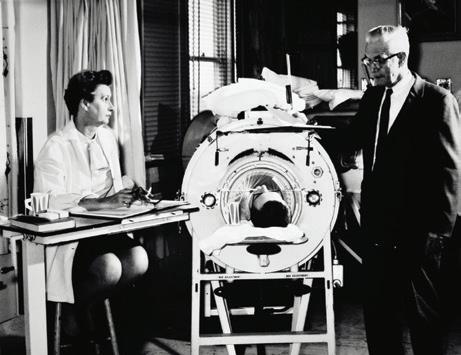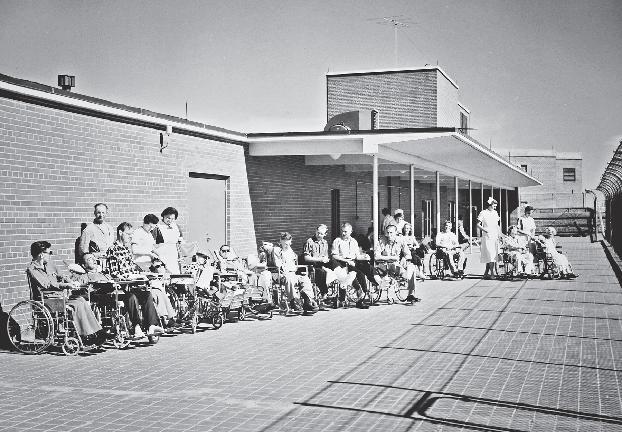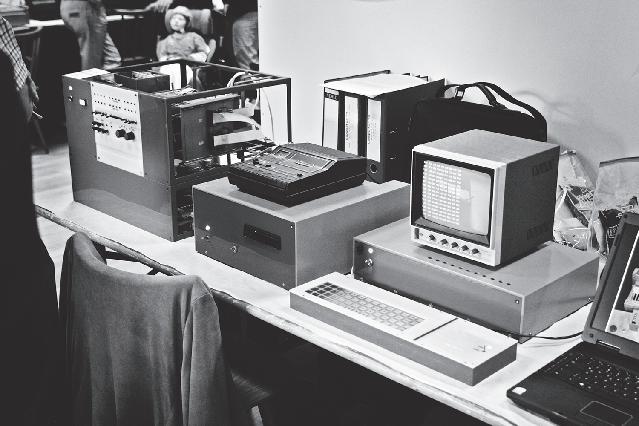
6 minute read
Throwback
Five summer student researchers who went on to do great things
AUTHOR
Advertisement
AMY SAMSON
ARTWORK BY
NATASIA DESIGNS
EDITED BY
SASHA ROEDER MAH
THE LARGEST IN CANADA, THE UALBERTA FACULTY OF MEDICINE & DENTISTRY’S SUMMER STUDENT RESEARCH PROGRAM BEGAN IN 1969. HERE ARE FIVE SUMMER-STUDENT RESEARCHERS WHO HAVE CONTRIBUTED SIGNIFICANTLY TO THE ADVANCEMENT OF HEALTH SCIENCE
Dennis Modry, ’73 MD
A SUMMER OF WORK WITH ANIMAL MODELS LED TO THE FIRST HEART AND HEART-LUNG COMBINED TRANSPLANTS IN WESTERN CANADA
DENNIS MODRY, WHO graduated from IN 1970, BARBARA Romanowski presented at the summer student research day on a project with what was then the Department of Community Medicine. Romanowski completed her MD at the U of A in
the U of A’s school of medicine in 1973, spent the summer after his first year working in the Surgical-Medical Research Institute doing heart-lung transplants in 1973, followed by specialized training in infectious diseases. From 1979 until 1998, she was director of Alberta’s sexually transmitted diseases (STD) program and was involved with Edmonton’s AIDS Network, now HIV Edmonton. She has also been involved in humanpapillomavirus (HPV) clinical trials for more than a decade and has published extensively on STDs. She is currently a clinical professor in the division of infectious diseases at the U of A.
Funding partners
Since the 1980s, the program has been supported by the Alberta Heritage Foundation for Medical Research, Alberta Innovates, alumni donors, the Faculty of Medicine & Dentistry and many others .
animal models. After training in surgery in Montreal, Modry accepted a position at Stanford, where he was chief of the transplant division before returning to the U of A in the 1980s to pilot a heart-lung transplant program. During that time, Modry performed the first heart transplant and the first heart-lung combined transplant in Western Canada. The University of Alberta Hospital’s heart and lung transplant program is now one
Barbara Romanowski, ’73 MD
PASSION FOR COMMUNITY HEALTH MADE FORMER SUMMER STUDENT A LEADER IN SEXUALLY TRANSMITTED DISEASE RESEARCH
of the nation’s busiest.
Sir John Bell, ’75 BMedSc, ’03 DSc (Hon)
FORMER HONOURS STUDENT IN MEDICAL SCIENCE KNIGHTED FOR HIS PIONEERING WORK IN THE CLINICAL APPLICATION OF GENETICS
at the 1983 summer research day, completed an MD at the U of A in 1986, winning the Harry Weinlos Prize in Medicine, awarded to a student who demonstrates humanitarianism and an excellent academic record. She went on to a residency in internal BEFORE GRADUATING FROM the U of A in 1975 with a bachelor’s in medical science (honours), Sir John Bell— together with Raymond Yee—won first place at summer student research day. medicine, followed by a fellowship in geriatric medicine. McElhaney is a leader in influenza research, particularly in aging populations. She sits on a number of boards and committees, including, as of 2016, the federal Institute Advisory Board for Indigenous Peoples’ Health. She currently works with the Health Sciences North Research Institute in Sudbury, Ontario.
Lewis E. Kay, ’83 BSc
FOUR YEARS OF SUMMERSCHOOL BIOCHEMISTRY LAB WORK EVENTUALLY LED TO 2017 CANADA GAIRDNER INTERNATIONAL AWARD researching nuclear magnetic resonance (NMR) throughout his undergraduate degree and graduated with a bachelor of science in biochemistry in 1983. He obtained his doctor of philosophy in molecular biophysics from Yale A Rhodes Scholar, he attended Oxford and Stanford universities and is currently the Regius professor of medicine at Oxford, where he founded the Wellcome Trust Centre for Human Genetics.
Bell was made a Knight Bachelor in 2008 and, in 2015, a Knight of the Grand Cross of the Order of the British Empire. In 2009, he won the Henry G. Friesen International Prize
Janet McElhaney, ’86 MD
A RESEARCH LEADER IN INFLUENZA AMONG AGING POPULATIONS
JANET MCELHANEY, WHO presented
LEWIS KAY WAS a summer student in Health Research. University in 1988, followed by postdoctoral studies at the National Institutes of Health. He is a senior scientist in molecular medicine at the Hospital for Sick Children in Toronto and a Canada Research Chair in Proteomics, Bioinformatics and Functional Genomics.
In 2017, Kay was named Canada Gairdner International Award Laureate for “the development of modern NMR spectroscopy for studies of biomolecular structure dynamics and function, including applications to molecular machines and rare protein conformations.”
IRON LUNG
A negative pressure ventilator, known colloquially as an IRON LUNG, works by decreasing pressure within the closed chamber to induce inhalation, then repressurizing to allow the patient to passively exhale. Today, positive pressure ventilation—forcing air into the lungs, then allowing the body to exhale naturally before repeating—has almost entirely superseded negative. Canada experiences its worst polio epidemic on record. An estimated 11,000 people in Canada are left paralyzed by polio between 1949 and 1954. The disease peaks in 1953 with nearly 9,000 cases and 500 deaths.
POLIO TEAM

Much like wartime did, the epidemic brings together patients, doctors, nurses, community members, and later respiratory, physical and occupational therapists. During the 1953 epidemic, doctors, nurses; and orderlies frequently work extra hours and sometimes double shifts
1953
EPIDEMIC
without payment or time-off.
1956
NEW POLIO WING AT UAH

The majority of polio patients are transferred to the University of Alberta Hospital (UAH) from the Royal Alexandra Hospital. The provincial government commits to constructing a rehabilitation wing, which opens in 1956.
1968
FIRST ICU OPENS

The first Intensive Care Unit (ICU) at the UAH opens. The ICU is a direct legacy of the 1953 polio epidemic and the resulting care at the Royal Alexandra Hospital and University of Alberta Hospital.
1967
NEW TRAINING PROGRAM
Sproule helps develop the first Canadian respiratory technology course at the Northern Alberta Institute of Technology (NAIT). He later serves as head of the program for approximately 30 years.
1959–1960
BRIAN SPROULE Brian Sproule joins the University Hospital staff in 1959. In 1960, he becomes the first director of the clinical pulmonary division and establishes a pulmonary functions laboratory around the same time as another polio epidemic in Alberta.
GARNER KING

Garner King initiates the implementation of the first Intensive Care Unit at the University of Alberta Hospital in collaboration with Brian Sproule. Together, they develop an ICU advisory committee and facilitate the opening of a six-bed ICU on the former polio ward.
1973
NEW HOME
Remaining polio patients and staff move from the UAH to

the Aberhart Centre.
1980s
DIGITAL INNOVATION

Don Scott, polio survivor and the first head of the Department of Computing Science at the U of A, offers computer programming training to a small group of interested polio patients. The patients later set up Prodata services, the first customized computer programming company in Edmonton. IBM eventually takes over the company.
OFFICE OF ADVANCEMENT
2J2.00 Walter C. Mackenzie Health Sciences Centre 8440 - 112 Street Edmonton, AB Canada T6G 2R7

UALBERTA.CA/MEDICINE
E advadmin@ualberta.ca P 780-492-6621
Faculty of Medicine & Dentistry – University of Alberta @UAlberta_FoMD @UAlberta_FoMD










